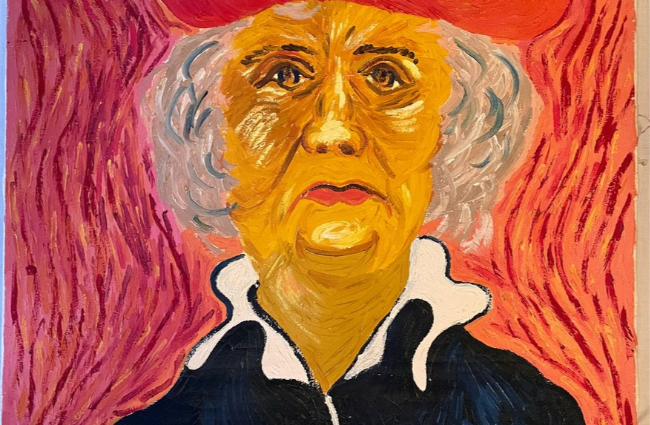What two siblings discovered about their father after his death—and why the public needs to see it, too.
WORDS BY KATIE DOHMAN
Siblings Miki and Martin Mosman were clearing out the home that belonged to their deceased father, Ron Mosman, in June 2020 when they made an unexpected discovery—the equivalent of a priceless parting gift: Two bundles of canvas tied with twine. One was socked away in the rafters of an attic, obscured by a summation of life’s collections, and one was under a pile of detritus in the airplane hangar he used to use for one of his hobbies: flying.
Between the two bundles, the siblings unearthed about 50 paintings.
It’s not that they didn’t know their father painted—they did. But the hangar paintings in particular raised some questions: Why had they never seen them? Why there were so many stowed away? When did he have the time to do them? “So many questions which will remain forever unanswered,” says Mosman.
The Mosman kids were shocked, but it reinforced that their father liked creating for creating’s sake, not accolades.
Miki says the pieces are “colorful and richly thematic—personal and yet still strangely universal, his interpretation of everyday activities based on his early years in rural Minnesota and then Washington state. The themes he chooses and the way he chooses to depict them are downright Technicolor at times,” she says of his post-Impressionist, Van Gogh-inspired style. “I feel a lot of his real artistry came when he did portraits, for he managed to pierce the subject’s soul and reveal their vitality as well as their vulnerability,” she says.
Ron Mosman did show some paintings, marked by clippings he had tucked away, but largely kept his artwork to himself, especially after family and career took center stage in his life. But he still painted.
“I said to him once, ‘Dad, you must really love painting since you do it so much.’ He said, ‘Actually, I hate it. It hurts me, but I have to get it out of me. I have to release it.’ That answer meant a lot because, to me, that is an artist’s soul,” Miki says. “I understood more about him at that point—which was when I was about 20 or so—than I ever had prior. It helped me to understand that art and the creation thereof is invaluable to the artist and so subjective to the viewer. It also helped me understand why someone wouldn’t want to experience the critiques of strangers whose opinions and words might stifle the spirit or bruise, batter, and destroy the very soul of the creator. The art and creation of it was for him and him alone, hence the binding and discarding of his colorful, imaginative, and sometimes painful, painted memories.”
Miki began posting the paintings once a week on social media, and this show, mounted at Q.Arma, came as a result of the social audience demanding to experience the work in real life.
“I think it’s important to show work like this—the work of an artist who isn’t classically trained—because it’s approachable art. It’s art made by someone who wanted to express themselves without the burden or the shackles of being classically trained. It’s art made by someone who had no intentions of allowing someone to tell them their art wasn’t ‘right’ or “good” or even “art”. To me, that’s an ‘outsider artist’- someone who creates because they ‘have to do it,’” she says.
And, she says, art made outside whatever is considered the “right” way is central to illustrating “visibility, accessibility, and cultural understanding of the experiences and psyche of the general populace. With greater visibility of the self-taught artist hopefully a greater understanding of the world we inhabit comes from discussions and discourse surrounding their work,” she says. “I hope if someone comes to see the art of Ron Mosman, they will walk away with a sweet understanding of life shown through the eyes of someone who wanted to capture fleeting glimpses of it.”
WHEN YOU GO
LIFE IS ART, A retrospective of the works of Ron Mosman
Gallery One features selection of physical works. Gallery Two features a multimedia presentation of his life, including his work as a radio DJ.
Q.arma Building, 1224 Quincy St NE, Mpls.
February 11-18 with an opening Reception Feb. 11, 6 PM

